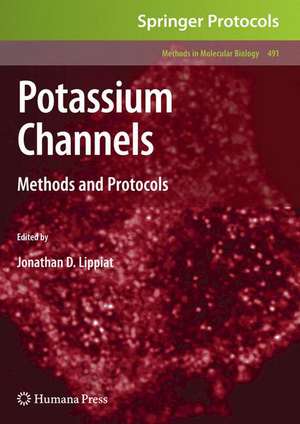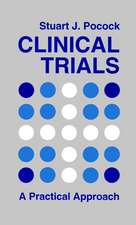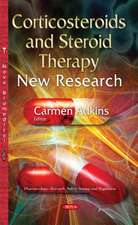Potassium Channels: Methods and Protocols: Methods in Molecular Biology, cartea 491
Editat de Jonathan D. Lippiaten Limba Engleză Hardback – 23 oct 2008
Thorough and cutting-edge, Potassium Channels: Methods and Protocols provides a wide range of approaches in order to aid current research projects and inspire new investigations.
| Toate formatele și edițiile | Preț | Express |
|---|---|---|
| Paperback (1) | 1033.90 lei 43-57 zile | |
| Humana Press Inc. – 19 noi 2010 | 1033.90 lei 43-57 zile | |
| Hardback (1) | 675.35 lei 38-44 zile | |
| Humana Press Inc. – 23 oct 2008 | 675.35 lei 38-44 zile |
Din seria Methods in Molecular Biology
- 9%
 Preț: 791.59 lei
Preț: 791.59 lei - 23%
 Preț: 598.56 lei
Preț: 598.56 lei - 20%
 Preț: 882.95 lei
Preț: 882.95 lei -
 Preț: 252.04 lei
Preț: 252.04 lei - 5%
 Preț: 802.69 lei
Preț: 802.69 lei - 5%
 Preț: 729.61 lei
Preț: 729.61 lei - 5%
 Preț: 731.43 lei
Preț: 731.43 lei - 5%
 Preț: 741.30 lei
Preț: 741.30 lei - 5%
 Preț: 747.16 lei
Preț: 747.16 lei - 15%
 Preț: 663.45 lei
Preț: 663.45 lei - 18%
 Preț: 1025.34 lei
Preț: 1025.34 lei - 5%
 Preț: 734.57 lei
Preț: 734.57 lei - 18%
 Preț: 914.20 lei
Preț: 914.20 lei - 15%
 Preț: 664.61 lei
Preț: 664.61 lei - 15%
 Preț: 654.12 lei
Preț: 654.12 lei - 18%
 Preț: 1414.74 lei
Preț: 1414.74 lei - 5%
 Preț: 742.60 lei
Preț: 742.60 lei - 20%
 Preț: 821.63 lei
Preț: 821.63 lei - 18%
 Preț: 972.30 lei
Preț: 972.30 lei - 15%
 Preț: 660.49 lei
Preț: 660.49 lei - 5%
 Preț: 738.41 lei
Preț: 738.41 lei - 18%
 Preț: 984.92 lei
Preț: 984.92 lei - 5%
 Preț: 733.29 lei
Preț: 733.29 lei -
 Preț: 392.58 lei
Preț: 392.58 lei - 5%
 Preț: 746.26 lei
Preț: 746.26 lei - 18%
 Preț: 962.66 lei
Preț: 962.66 lei - 23%
 Preț: 860.21 lei
Preț: 860.21 lei - 15%
 Preț: 652.64 lei
Preț: 652.64 lei - 5%
 Preț: 1055.50 lei
Preț: 1055.50 lei - 23%
 Preț: 883.85 lei
Preț: 883.85 lei - 19%
 Preț: 491.88 lei
Preț: 491.88 lei - 5%
 Preț: 1038.84 lei
Preț: 1038.84 lei - 5%
 Preț: 524.15 lei
Preț: 524.15 lei - 18%
 Preț: 2122.34 lei
Preț: 2122.34 lei - 5%
 Preț: 1299.23 lei
Preț: 1299.23 lei - 5%
 Preț: 1339.10 lei
Preț: 1339.10 lei - 18%
 Preț: 1390.26 lei
Preț: 1390.26 lei - 18%
 Preț: 1395.63 lei
Preț: 1395.63 lei - 18%
 Preț: 1129.65 lei
Preț: 1129.65 lei - 18%
 Preț: 1408.26 lei
Preț: 1408.26 lei - 18%
 Preț: 1124.92 lei
Preț: 1124.92 lei - 18%
 Preț: 966.27 lei
Preț: 966.27 lei - 5%
 Preț: 1299.99 lei
Preț: 1299.99 lei - 5%
 Preț: 1108.51 lei
Preț: 1108.51 lei - 5%
 Preț: 983.72 lei
Preț: 983.72 lei - 5%
 Preț: 728.16 lei
Preț: 728.16 lei - 18%
 Preț: 1118.62 lei
Preț: 1118.62 lei - 18%
 Preț: 955.25 lei
Preț: 955.25 lei - 5%
 Preț: 1035.60 lei
Preț: 1035.60 lei - 18%
 Preț: 1400.35 lei
Preț: 1400.35 lei
Preț: 675.35 lei
Preț vechi: 710.89 lei
-5% Nou
Puncte Express: 1013
Preț estimativ în valută:
129.22€ • 135.29$ • 106.93£
129.22€ • 135.29$ • 106.93£
Carte tipărită la comandă
Livrare economică 02-08 aprilie
Preluare comenzi: 021 569.72.76
Specificații
ISBN-13: 9781934115657
ISBN-10: 1934115657
Pagini: 312
Ilustrații: X, 302 p. 59 illus.
Dimensiuni: 193 x 260 x 22 mm
Greutate: 0.77 kg
Ediția:2009
Editura: Humana Press Inc.
Colecția Humana
Seria Methods in Molecular Biology
Locul publicării:Totowa, NJ, United States
ISBN-10: 1934115657
Pagini: 312
Ilustrații: X, 302 p. 59 illus.
Dimensiuni: 193 x 260 x 22 mm
Greutate: 0.77 kg
Ediția:2009
Editura: Humana Press Inc.
Colecția Humana
Seria Methods in Molecular Biology
Locul publicării:Totowa, NJ, United States
Public țintă
Professional/practitionerCuprins
Methods For Studying Potassium Channel Transcription And Mrna Splicing.- Identifying Transcriptional Regulatory Regions Using Reporter Genes and DNA—Protein Interactions by Chromatin Immunoprecipitation.- Quantitative RT-PCR Methods for Investigation of Low Copy Potassium Channel Gene Expression in Native Murine Arteries.- Cloning of Potassium Channel Splice Variants from Tissues and Cells.- Methods for Studying the Cell Biology of Potassium Channel Proteins.- Chemiluminescence Assays to Investigate Membrane Expression and Clathrin-Mediated Endocytosis of KATP Channels.- Investigation of KATP Channel Endocytosis by Immunofluorescence.- Investigation of KATP Channel Endocytosis and Cell Surface Density by Biotinylation and Western Blotting.- Lipid Microdomains and K+ Channel Compartmentation: Detergent and Non-Detergent-Based Methods for the Isolation and Characterisation of Cholesterol-Enriched Lipid Rafts.- Determination of Phosphoinositide Binding to K+ Channel Subunits Using a Protein—Lipid Overlay Assay.- Protein Complex Analysis of Native Brain Potassium Channels by Proteomics.- Electrophysiological Techniques For The Study Of Potassium Channel Function.- Xenopus Oocytes as a Heterologous Expression System for Studying Ion Channels with the Patch-Clamp Technique.- Whole-Cell Recording Using the Perforated Patch Clamp Technique.- Recording the Activity of ATP-Sensitive K+ Channels in Open-Cell Cell-Attached Configuration.- Planar Patch Clamp: Advances in Electrophysiology.- Analysing Steroid Modulation of BKCa Channels Reconstituted into Planar Lipid Bilayers.- Optical Techniques For The Study Of Potassium Channel Function And Interactions.- Using Bioluminescence Resonance Energy Transfer to Measure Ion Channel Assembly.- The Use of FRET Microscopy to ElucidateSteady State Channel Conformational Rearrangements and G Protein Interaction with the GIRK Channels.- The Voltage-Clamp Fluorometry Technique.- Methods For Studying Potassium Channelopathies And Pharmacological Modulators.- Identification of Mutations in the Kir6.2 Subunit of the KATP Channel.- Modulation of Potassium Ion Channel Proteins Utilising Antibodies.- Fluorescence-Based Tl+?Influx Assays as a Novel Approach for Characterization of Small-Conductance Ca2+?Activated K+ Channel Modulators.- Rubidium Efflux as a Tool for the Pharmacological Characterisation of Compounds with BK Channel Opening Properties.- Recording hERG Potassium Currents and Assessing the Effects of Compounds Using the Whole-Cell Patch-Clamp Technique.
Recenzii
From the reviews:
"This is a very informative book, covering a variety of methods available to study potassium channels … . The protocols are clearly organized and usefully detailed. … Illustrative figures and in some cases, photographs of equipment … adding to the clarity of the methods sections. This book … a valuable reference not only for those already in the potassium channel field but also for studies of other ion channel systems. … each chapter allows bench scientists to undertake new, informed, experimental approaches in their research." (Samantha Miller, Microbiology Today, July, 2009)
“This book is dedicated to experimental methods, which allow us to investigate potassium channels from their genes through gene transcription to protein structure, function and regulation in health and disease. … chapters in this book are written in form of practical laboratory protocols. Therefore the book will be primarily used by practicing scientists and by graduated and post-graduate students for their practical research. Certainly it will find its place in many laboratories investigating various features of potassium channels regulations.” (Ľubica Lacinová, General Physiology and Biophysics, Vol. 29, April, 2010)
"This is a very informative book, covering a variety of methods available to study potassium channels … . The protocols are clearly organized and usefully detailed. … Illustrative figures and in some cases, photographs of equipment … adding to the clarity of the methods sections. This book … a valuable reference not only for those already in the potassium channel field but also for studies of other ion channel systems. … each chapter allows bench scientists to undertake new, informed, experimental approaches in their research." (Samantha Miller, Microbiology Today, July, 2009)
“This book is dedicated to experimental methods, which allow us to investigate potassium channels from their genes through gene transcription to protein structure, function and regulation in health and disease. … chapters in this book are written in form of practical laboratory protocols. Therefore the book will be primarily used by practicing scientists and by graduated and post-graduate students for their practical research. Certainly it will find its place in many laboratories investigating various features of potassium channels regulations.” (Ľubica Lacinová, General Physiology and Biophysics, Vol. 29, April, 2010)
Textul de pe ultima copertă
Due to the importance of potassium channels in cellular function, researchers have been challenged to develop tools and experimental procedures to probe the function and identify chemicals that modulate the behaviour of this super-family of ion channels. In Potassium Channels: Methods and Protocols, experts in the field present a range of experimental approaches that have been developed to investigate potassium channel structure, function, pharmacology, cell biology, gene expression, and their role in disease. Many of these techniques study potassium channels as cellular proteins as well as the resultant membrane biophysics. Written in the highly successful Methods in Molecular Biology™ series format, the chapters contain brief introductions to the subject, lists of the necessary materials and reagents, readily reproducible laboratory protocols, and a Notes section, which highlights tips on troubleshooting and avoiding known pitfalls.
Thorough and cutting-edge, Potassium Channels: Methods and Protocols provides a wide range of approaches in order to aid current research projects and inspire new investigations.
Thorough and cutting-edge, Potassium Channels: Methods and Protocols provides a wide range of approaches in order to aid current research projects and inspire new investigations.
Caracteristici
Contains detailed protocols that describe the use of routine and advanced electrophysiological techniques, such as whole cell patch clamp, perforated patch clamp, excised macropatch, open-cell cell-attached patch clamp, planar patch clamp, and artificial bilayer Of major pharmacological interest as a number of chapters describe the use of potassium channel drug screening platforms, planar electrophysiology, and the cardiac safety pharmacology of HERG potassium channels Describes optical techniques that allow the real-time study of protein interactions and conformational changes in potassium channels Examines both functional experiments and protocols that allow the evaluation of the cellular biology of potassium channels, like transcription, splicing, and protein trafficking Features standard laboratory techniques such as cell culture and transfection, oocyte injection, Western blotting, PCR to support these experiments Includes supplementary material: sn.pub/extras










